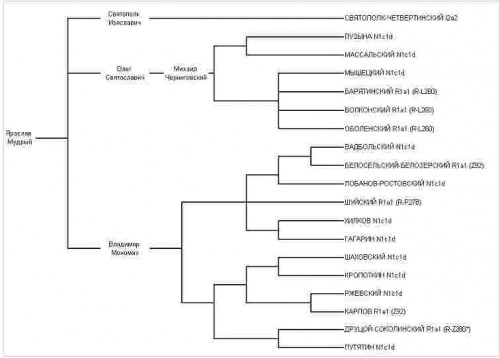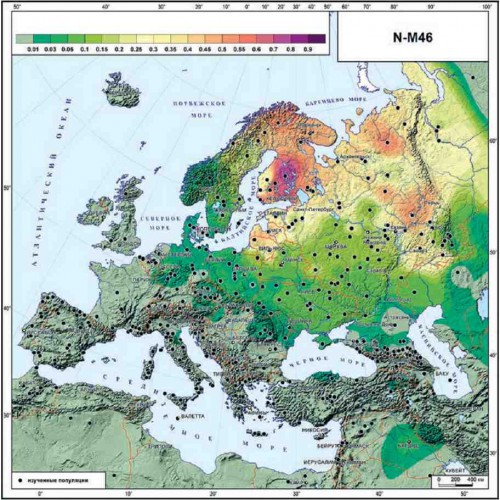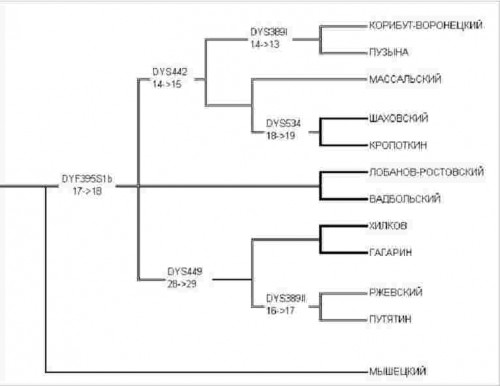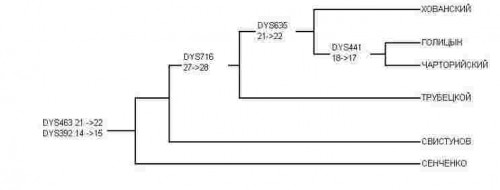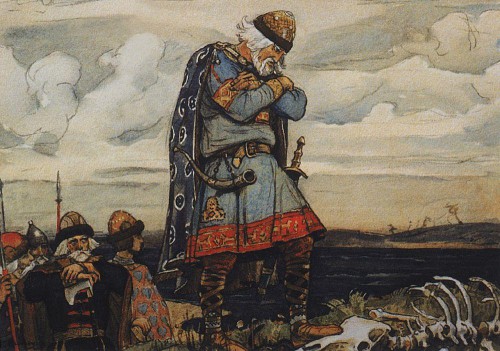Post by Admin on Aug 9, 2019 18:27:46 GMT
Anyway, chapter 14 in the book is really called “DNA genealogy against the Norman theory,” the subtitle reveals that the chapter is devoted to Rurikovich: “About the“ Swedish ”and“ Finno-Ugric ”roots of Rurik, which is not true”. There is another chapter in the book, the preceding one, i.e. 13, bearing the same name, but the subtitle of another one - it shows that its content comes down to the defense of M. N. Zadornov's anti-Norman film from criticism. Since I have already dwelt on this ignorant work in other notes (Klein 2012, p.12; 2013b, p.12), I will not linger on it here. It is even strange, as Klyosov, a natural scientist, does not notice the stunning anti-science of this film, designed for the lowest instincts of the crowd.
There is also a third chapter in the book (on account of the 15th) with the same title (“... against the Norman theory”), but with another subtitle: “Responses to responses”. Here Klyosov leads the critical attacks of the "Normanists," selected by him to show the nastiness and stupidity of these "anti-patriots", and repeats his objections expressed in various discussions. I got here too. He is intoxicated with his answers, and it seems to him that his opponents have been refuted and confounded. Apparently, he does not imagine that his arguments are convincing only for those lovers who share his feelings and addictions and are ready to intervene on his side with only a cry of “Ours are beaten!”.
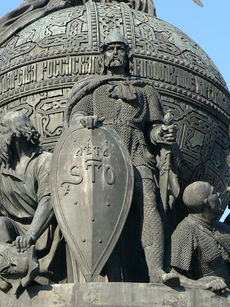
Here Klyosov touched upon and the main arguments of the “normanophiles”: “they are dragging everything“ to the heap ”- and the fact that they found in ancient Russian villages buildings made of six-sided logs, which are also in Scandinavia, and that who lived in the tenth century, allegedly wrote that all the Dnieper rapids had "Scandinavian names", and that the ambassadors and merchants of the ancient Russian princes had very often "Scandinavian names". I would not even consider it, because it’s all a wishful thinking.”
But still putting forward several objections (the emperor, after all, brought Slavic names - true, but he called them Russian, and these Slavic!), Klyosov casually threw out: “Yes, and mine is not my specialty” (Klyosov 2013: p. 330). It would be so long!- about this and much more. Another speech by A. A. Klesov is entitled “The Origin of Rurikovich: DNA Genealogy”. This is a review of the film of the end of 2012 “Russia. The origin of statehood. Identification Rurikovich. This film was opposed to the same Zadornovsky, met by Klyosov with unreasonable admiration, respectively, this new film could not come to his taste. He shows this in every way: he says about the film that it was made with the participation of "a certain Elena Melnikova" (the famous Scandinavian philologist) and Balanovsky, the author of "scientific profanation" (the capital work "Russian Genofund"). However, Klyosov and useful remarks come across. So, he said that “for the phrase that sounded at the very beginning, that“ every ethnic group has its own haplogroup ”, it is necessary to drive it out without severance pay. Ethnic groups are almost always associations of different haplogroups. They do not have "their haplogroup." There are four main haplogroups in the Russian ethnos - R1a, I1, I2, and N1 c1, plus a dozen more minor ones, which among Russians range from a few percent to fractions of a percent. That they are not Russian ethnos?”
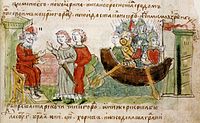
The third performance was a conversation between Klyosov and TV presenter Dionys Kaptar and entitled “Rurik and Rurikovich according to DNA genealogy” on KM-TV channel (the most shameless of Stalinist channels). This program is reprinted by many sites under the caps: “The last nail in the coffin of the Norman theory,” “We launder Rurik off Normanism,” and so on.
From this list it is clear that Klyosov reduces the refutation of the Normans belonging to the Vikings to a refutation of the Scandinavian origin of Rurikovich, and this is not the same thing. After all, it is analogous to reducing the evidence or refutation of the Slavs of the Russians to the proof or refutation of the Slavs of the Romanovs. After Peter I, they were obviously not blood-slavs. As the pure Swedes of Bernadotta in Sweden were not, the pure British were the Windsor dynasty in England, etc. This substitution means a voluntary or involuntary trick. Let us leave aside the typical Klesovian methods of controversy with opponents - rude personal attacks, insipid mockery, political accusations (of anti-patriotism, of treason, etc.). He loves to choose a random figure, to find reservations or mistakes in it, to declare them typical and to stomp on them, pretending that he dealt with the whole direction in science. It's a pity. The man is really talented and hard-working, but too self-confident and narcissistic. His judgments are absolutely categorical, and if anyone seriously argues, then war is waged against this by all means.
Let us proceed directly to the Klesov analysis of the haplotypes of Rurikids. Again, I will not go beyond my competence - I will not evaluate the Klesov definitions of haplotypes, snaps, dating, etc. Perhaps they are controversial, maybe - indisputable, I leave it for DNA specialists. We take all this conditionally for the proven. We also note that the survey of all descendants of the princes and the identification of haplotypes was carried out by completely different people, and Klyosov only used the published data, but the calculations of proximity and dating are his.
In short, the history of genetic examination of Rurik looks like. Two researchers began this survey in 2006 in two centers: in Russia Nikita Maksimov from the Russian Newsweek magazine, and in America (Texas) Andrzej Bayor under the auspices of Family Tree DNA. They managed to persuade (each their own group) the descendants of princely clans, originating from Rurikovich, to undergo DNA testing. Then they were joined by a third center in Tomsk (Vladimir Volkov and Stanislav Dumin), who also surveyed some descendants of Rurik. It was Tomsk researcher VG Volkov (2012) who published the most extensive and deep research on this material.
There is also a third chapter in the book (on account of the 15th) with the same title (“... against the Norman theory”), but with another subtitle: “Responses to responses”. Here Klyosov leads the critical attacks of the "Normanists," selected by him to show the nastiness and stupidity of these "anti-patriots", and repeats his objections expressed in various discussions. I got here too. He is intoxicated with his answers, and it seems to him that his opponents have been refuted and confounded. Apparently, he does not imagine that his arguments are convincing only for those lovers who share his feelings and addictions and are ready to intervene on his side with only a cry of “Ours are beaten!”.

Here Klyosov touched upon and the main arguments of the “normanophiles”: “they are dragging everything“ to the heap ”- and the fact that they found in ancient Russian villages buildings made of six-sided logs, which are also in Scandinavia, and that who lived in the tenth century, allegedly wrote that all the Dnieper rapids had "Scandinavian names", and that the ambassadors and merchants of the ancient Russian princes had very often "Scandinavian names". I would not even consider it, because it’s all a wishful thinking.”
But still putting forward several objections (the emperor, after all, brought Slavic names - true, but he called them Russian, and these Slavic!), Klyosov casually threw out: “Yes, and mine is not my specialty” (Klyosov 2013: p. 330). It would be so long!- about this and much more. Another speech by A. A. Klesov is entitled “The Origin of Rurikovich: DNA Genealogy”. This is a review of the film of the end of 2012 “Russia. The origin of statehood. Identification Rurikovich. This film was opposed to the same Zadornovsky, met by Klyosov with unreasonable admiration, respectively, this new film could not come to his taste. He shows this in every way: he says about the film that it was made with the participation of "a certain Elena Melnikova" (the famous Scandinavian philologist) and Balanovsky, the author of "scientific profanation" (the capital work "Russian Genofund"). However, Klyosov and useful remarks come across. So, he said that “for the phrase that sounded at the very beginning, that“ every ethnic group has its own haplogroup ”, it is necessary to drive it out without severance pay. Ethnic groups are almost always associations of different haplogroups. They do not have "their haplogroup." There are four main haplogroups in the Russian ethnos - R1a, I1, I2, and N1 c1, plus a dozen more minor ones, which among Russians range from a few percent to fractions of a percent. That they are not Russian ethnos?”

The third performance was a conversation between Klyosov and TV presenter Dionys Kaptar and entitled “Rurik and Rurikovich according to DNA genealogy” on KM-TV channel (the most shameless of Stalinist channels). This program is reprinted by many sites under the caps: “The last nail in the coffin of the Norman theory,” “We launder Rurik off Normanism,” and so on.
From this list it is clear that Klyosov reduces the refutation of the Normans belonging to the Vikings to a refutation of the Scandinavian origin of Rurikovich, and this is not the same thing. After all, it is analogous to reducing the evidence or refutation of the Slavs of the Russians to the proof or refutation of the Slavs of the Romanovs. After Peter I, they were obviously not blood-slavs. As the pure Swedes of Bernadotta in Sweden were not, the pure British were the Windsor dynasty in England, etc. This substitution means a voluntary or involuntary trick. Let us leave aside the typical Klesovian methods of controversy with opponents - rude personal attacks, insipid mockery, political accusations (of anti-patriotism, of treason, etc.). He loves to choose a random figure, to find reservations or mistakes in it, to declare them typical and to stomp on them, pretending that he dealt with the whole direction in science. It's a pity. The man is really talented and hard-working, but too self-confident and narcissistic. His judgments are absolutely categorical, and if anyone seriously argues, then war is waged against this by all means.
Let us proceed directly to the Klesov analysis of the haplotypes of Rurikids. Again, I will not go beyond my competence - I will not evaluate the Klesov definitions of haplotypes, snaps, dating, etc. Perhaps they are controversial, maybe - indisputable, I leave it for DNA specialists. We take all this conditionally for the proven. We also note that the survey of all descendants of the princes and the identification of haplotypes was carried out by completely different people, and Klyosov only used the published data, but the calculations of proximity and dating are his.
In short, the history of genetic examination of Rurik looks like. Two researchers began this survey in 2006 in two centers: in Russia Nikita Maksimov from the Russian Newsweek magazine, and in America (Texas) Andrzej Bayor under the auspices of Family Tree DNA. They managed to persuade (each their own group) the descendants of princely clans, originating from Rurikovich, to undergo DNA testing. Then they were joined by a third center in Tomsk (Vladimir Volkov and Stanislav Dumin), who also surveyed some descendants of Rurik. It was Tomsk researcher VG Volkov (2012) who published the most extensive and deep research on this material.

